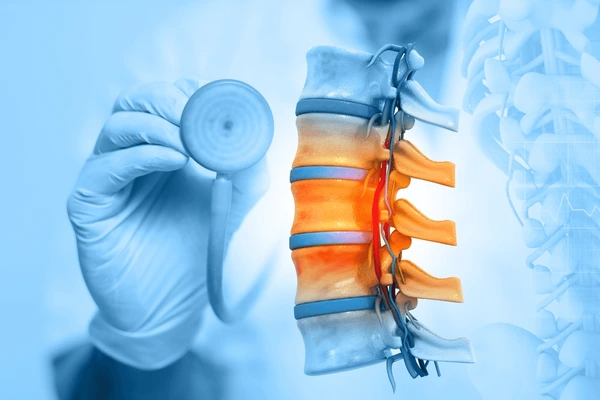How to Keep Your Lumbar Spine Healthy When You Sit All Day

A healthy lumbar spine is essential for overall well-being, especially with today’s sedentary lifestyles. Proper lumbar support can significantly enhance comfort during long periods of sitting.
The Importance of Maintaining a Healthy Lumbar Spine
Maintaining a healthy lumbar spine is essential for overall well-being. It supports the upper body and enables daily activities like bending, lifting, and rotating. The lumbar spine, consisting of five vertebrae in the lower back, bears much of the body’s weight and requires proper care to prevent issues like back pain and muscle strain.
If the lumbar spine is compromised, conditions such as herniated discs and osteoarthritis can lead to significant discomfort and decreased mobility. For those facing more severe spine issues, Surgery Consultants can provide expert advice and treatment options tailored to your condition.
Keeping the lumbar spine healthy involves understanding spinal alignment, managing weight, and incorporating regular exercise and stretching. By focusing on lumbar care, individuals can improve posture, reduce back pain, and enhance their ability to perform everyday tasks, leading to a more active and pain-free life.
Causes of Lumbar Spine Issues and Back Pain
Lumbar spine issues often stem from factors like a sedentary lifestyle, poor posture, and injury or trauma, all of which can contribute to chronic lower back pain and discomfort. A sedentary lifestyle, marked by prolonged sitting, can lead to muscle imbalances and back pain, making it essential to incorporate regular movement, such as taking breaks for stretching or walking, into daily routines. Poor posture, particularly when sitting without proper lumbar support, can compromise spinal alignment and increase back strain. Using ergonomic chairs and being mindful of body alignment can help alleviate these issues.
Additionally, injuries or trauma, whether from sports or accidents, can cause severe lumbar spine problems like herniated discs, requiring targeted rehabilitation strategies. Physical therapists often recommend strengthening exercises, stretching, and manual therapy to support recovery and manage pain effectively. Individuals can improve their spinal health and overall well-being by addressing these factors.
Signs and Symptoms of Lumbar Spine Issues
Recognizing the signs and symptoms of lumbar spine issues is crucial for early intervention and effective management. These issues can manifest as lower back pain, numbness or tingling in the legs, and difficulty standing or sitting for long periods. Back pain, which can range from mild discomfort to chronic, debilitating pain, is a standard indicator of lumbar problems, often linked to conditions like herniated discs or spinal stenosis.
This pain can significantly impact daily life, making simple tasks challenging and affecting mental well-being. Numbness or tingling in the legs often signals nerve compression, commonly associated with sciatica, where poor posture and sitting habits can exacerbate symptoms. Additionally, individuals with lumbar spine issues may struggle to stand or sit for extended periods due to pain and discomfort. Proper posture, ergonomic support, and targeted exercises can help manage these symptoms, improving mobility and quality of life.
How to Keep Your Lumbar Spine Healthy
Maintaining a healthy lumbar spine is vital for overall well-being, and this can be achieved through several effective strategies, such as setting up an ergonomic workstation, incorporating regular exercise, and practicing proper lifting techniques. An ergonomic workstation ensures that your chair, desk, and posture are aligned to support your spine, reducing strain during long hours of sitting.
Regular exercise and stretching, especially activities that strengthen core muscles and improve flexibility, help maintain spinal health and prevent discomfort. Proper lifting techniques, like bending at the knees and keeping the back straight, protect the lumbar spine from injury. Additionally, maintaining good posture throughout daily activities is crucial for reducing the risk of back pain and promoting overall physical wellness. By adopting these practices, individuals can improve their spinal health and enhance their quality of life.
Tips for Those Who Sit All Day
For those who spend long hours sitting, it’s important to take proactive steps to protect lumbar spine health and prevent discomfort. Here are some key strategies to incorporate:
- Take frequent breaks to stand, stretch, or walk to counteract strain from prolonged sitting.
- Use a lumbar support pillow to improve posture and provide lower back support.
- Incorporate strength and flexibility exercises, such as planks, torso twists, and supermans, to strengthen core muscles and enhance mobility.
- Consider using a standing desk to promote better posture, increase energy levels, and encourage movement throughout the day.
Conclusion
Maintaining a healthy lumbar spine is key to overall well-being and can be achieved by combining ergonomic practices, regular exercise, and mindful posture correction. Incorporating these changes into daily routines supports long-term spinal health, helping to manage discomfort and improve quality of life.
Engaging in targeted stretches and strength training strengthens the muscles around the lumbar region, while using ergonomic furniture and properly aligning workspaces encourages optimal posture. Awareness of early signs of discomfort allows for timely intervention, reducing the risk of chronic pain. Prioritizing spinal health through these measures can lead to a more active, pain-free lifestyle.









